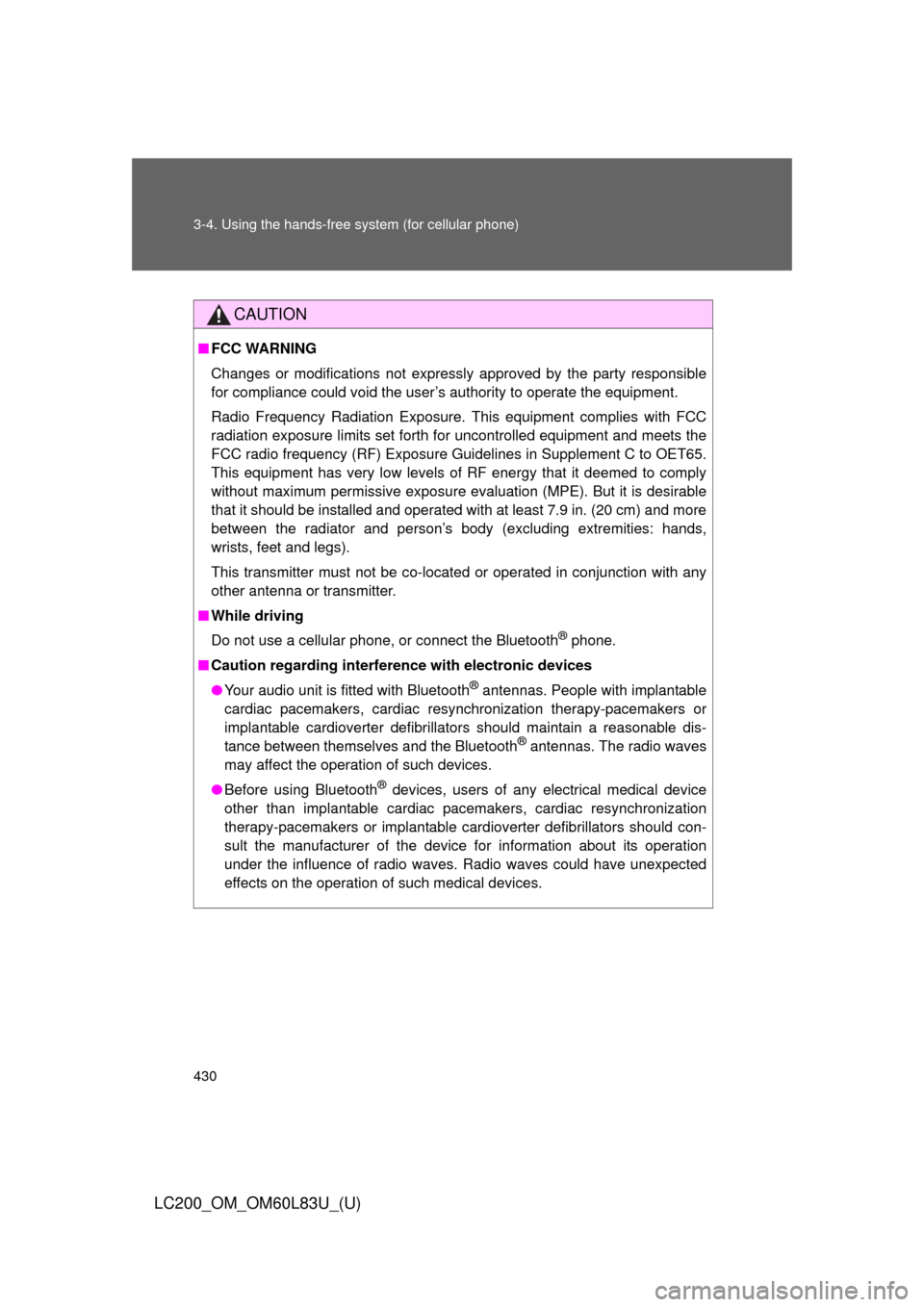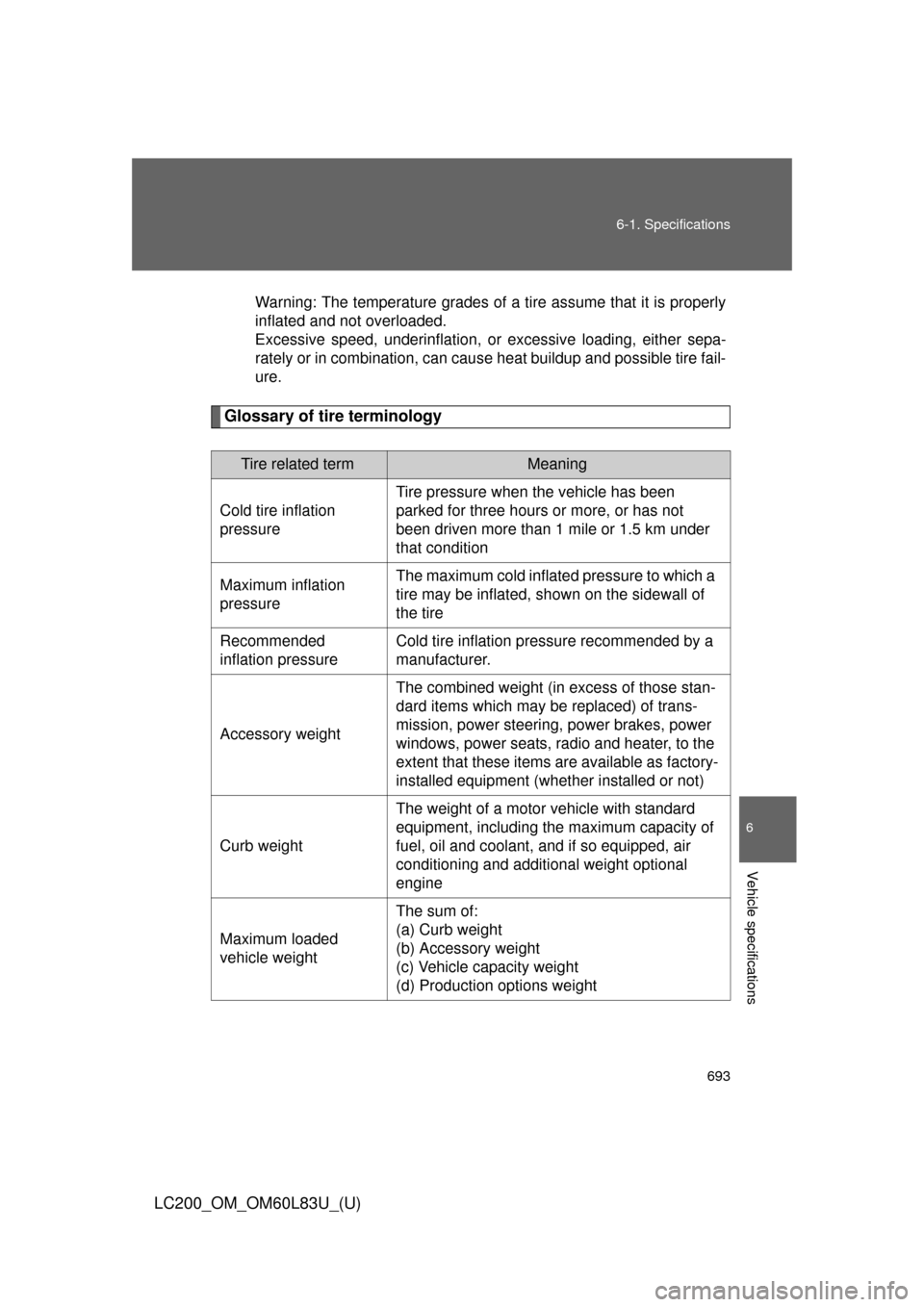2015 TOYOTA LAND CRUISER radio
[x] Cancel search: radioPage 430 of 728

430 3-4. Using the hands-free system (for cellular phone)
LC200_OM_OM60L83U_(U)
CAUTION
■FCC WARNING
Changes or modifications not expressly approved by the party responsible
for compliance could void the user’s authority to operate the equipment.
Radio Frequency Radiation Exposure. This equipment complies with FCC
radiation exposure limits set forth for uncontrolled equipment and meets the
FCC radio frequency (RF) Exposure Gui delines in Supplement C to OET65.
This equipment has very low levels of RF energy that it deemed to comply
without maximum permissive exposure evaluation (MPE). But it is desirable
that it should be installed and operated with at least 7.9 in. (20 cm) and more
between the radiator and person’s body (excluding extremities: hands,
wrists, feet and legs).
This transmitter must not be co-located or operated in conjunction with any
other antenna or transmitter.
■ While driving
Do not use a cellular phone, or connect the Bluetooth
® phone.
■ Caution regarding interfer ence with electronic devices
● Your audio unit is fitted with Bluetooth
® antennas. People with implantable
cardiac pacemakers, cardiac resynchronization therapy-pacemakers or
implantable cardioverter defibrillators should maintain a reasonable dis-
tance between themselves and the Bluetooth
® antennas. The radio waves
may affect the operation of such devices.
● Before using Bluetooth
® devices, users of any electrical medical device
other than implantable cardiac pacemakers, cardiac resynchronization
therapy-pacemakers or implantable cardioverter defibrillators should con-
sult the manufacturer of the device for information about its operation
under the influence of radio waves. Radio waves could have unexpected
effects on the operation of such medical devices.
Page 513 of 728

513
3-7. Other interior features
3
Interior features
LC200_OM_OM60L83U_(U)
Safety information for Safety Connect
Important! Read this information before using Safety Connect.
■ Exposure to radio frequency signals
The Safety Connect system installed in your vehicle is a low-power
radio transmitter and receiver. It receives and also sends out radio
frequency (RF) signals.
In August 1996, the Federal Communications Commission (FCC)
adopted RF exposure guidelines with safety levels for mobile wire-
less phones. Those guidelines are consistent with the safety stan-
dards previously set by the fo llowing U.S. and international
standards bodies.
● ANSI (American National Stand ards Institute) C95.1 [1992]
● NCRP (National Council on Radiation Protection and Measure-
ment) Report 86 [1986]
● ICNIRP (International Commiss ion on Non-Ionizing Radiation
Protection) [1996]
Those standards were based on comprehensive and periodic eval-
uations of the relevant scientific literature. Over 120 scientists,
engineers, and physicians from universities, and government
health agencies and industries reviewed the available body of
research to develop the ANSI Standard (C95.1).
The design of Safety Connect complies with the FCC guidelines in
addition to those standards.
Page 514 of 728

514 3-7. Other interior features
LC200_OM_OM60L83U_(U)
■Certification for Safety Connect
FCC ID: O6Y-CDMRF101
FCC ID: XOECDMRF101B
FCC ID: N7NGTM2
FCC WARNING:
This equipment complies with FCC radiation exposure limits set forth for an
uncontrolled environment and meets the FCC radio frequency (RF)
Exposure Guidelines in Supplement C to OET65. This equipment should be
installed and operated keeping the radiator at least 20cm or more away from
person’s body (excluding extremities: hands, wrists, feet and ankles).
Page 621 of 728

5
When trouble arises
621
5-2. Steps to take in an emergency
LC200_OM_OM60L83U_(U)
■When a tire is replaced with a spare tire
The spare tire is also equipped with the tire pressure warning valve and
transmitter. The tire pressure warning li
ght will turn on if the tire inflation
pressure of the spare tire is low. If a tire goes flat, even though the flat
tire is replaced with the spare tire, the tire pressure warning light does
not turn off. Replace the spare tire with the repaired tire and adjust the
proper tire inflation pressure. The ti re pressure warning light will turn off
after a few minutes.
■If the tire pressure warning system is inoperative
The tire pressure warning system will be disabled in the following condi-
tions:
(When the condition be comes normal, the system will work properly.)
●If tires not equipped with tire pressure warning valves and transmit-
ters are used.
●If the ID code on the tire pressure warning valves and transmitters is
not registered in the tire pressure warning computer.
●If the tire inflation pressure is 73 psi (500 kPa, 5.1 kgf/cm2 or bar) or
higher.
The tire pressure warning system may be disabled in the following condi-
tions:
(When the condition be comes normal, the system will work properly.)
●If electronic devices or facilities using similar radio wave frequencies
are nearby.
●If a radio set at similar frequencies is in use in the vehicle.
●If a window tint that affects the radio wave signals is installed.
●If there is a lot of snow or ice on the vehicle, in particular around the
wheels or wheel housings.
●If non-genuine Toyota wheels are used. (Even if you use Toyota
wheels, the tire pressu re warning system may not work properly with
some types of tires.)
●If tire chains are used.
●If the spare tire is in a location subject to poor radio wave signal
reception.
●If a large metallic object which can interfere with signal reception is
put in the luggage compartment.
Page 693 of 728

693
6-1. Specifications
6
Vehicle specifications
LC200_OM_OM60L83U_(U)
Warning: The temperature grades of a tire assume that it is properly
inflated and not overloaded.
Excessive speed, underinflation, or
excessive loading, either sepa-
rately or in combination, can caus e heat buildup and possible tire fail-
ure.
Glossary of tire terminology
Tire related termMeaning
Cold tire inflation
pressure Tire pressure when the vehicle has been
parked for three hours or more, or has not
been driven more than 1 mile or 1.5 km under
that condition
Maximum inflation
pressure The maximum cold inflated
pressure to which a
tire may be inflated, s hown on the sidewall of
the tire
Recommended
inflation pressure Cold tire inflation pressure recommended by a
manufacturer.
Accessory weight The combined weight (in excess of those stan-
dard items which may be replaced) of trans-
mission, power steering, power brakes, power
windows, power seats, radio and heater, to the
extent that these items
are available as factory-
installed equipment (whether installed or not)
Curb weight The weight of a motor vehicle with standard
equipment, including the maximum capacity of
fuel, oil and coolant, and if so equipped, air
conditioning and additional weight optional
engine
Maximum loaded
vehicle weight The sum of:
(a) Curb weight
(b) Accessory weight
(c) Vehicle capacity weight
(d) Production options weight
Page 715 of 728

715
Abbreviation list
LC200_OM_OM60L83U_(U)
ABBREVIATIONSMEANING
M+S Mud and Snow
MTBE Methyl Tertiary Butyl Ether
PCS Pre-Collision System
PWR Power
RDS Radio Data System
RSCA Roll Sensing of Curtain Shield airbag
SRS Supplemental Restraint System
TIN Tire Identification Number
TPMS Tire Pressure Warning System
TRAC Traction Control
TWR Trailer Weight Rating
VIN Vehicle Identification Number
VSC Vehicle Stability Control
Page 716 of 728

716
LC200_OM_OM60L83U_(U)
Alphabetical index
Alphabetical index
A/CAir conditioning filter .............. 564
Automatic air conditioning
system (vehicles without
navigation system) .............. 340
Automatic air conditioning system (vehicles with
navigation system)
*
ABS ........................................... 285
Active traction control ............. 285
Air conditioning filter............... 564
Air conditioning system(vehicles without
navigation system)Air conditioning filter .............. 564
Automatic air conditioning
system ................................ 340
Air conditioning system
(vehicles with navigation
system)
*
Airbags Airbag operating conditions... 120
Airbag precautions for your child .................................... 125
Airbag warning light............... 615
Curtain shield airbag operating conditions............ 120
Curtain shield airbag precautions ......................... 125
Front passenger occupant
classification system ........... 132
General airbag precautions ... 125
Locations of airbags .............. 116
Modification and disposal of airbags ................................ 128
Proper driving posture ... 114, 125
Roll sensing of curtain shield
airbags off switch ................131
Side airbag operating
conditions............................ 120
Side airbag precautions ........ 125
SRS airbags .......................... 116 Alarm......................................... 110
Antenna .................................... 365
Anti-lock brake system ........... 285
Armrest ..................................... 495
Ashtrays ................................... 486
Assist grips .............................. 496
Audio input ............................... 401
Audio system (vehicles
without navigation system)Antenna................................. 365
Audio input ............................ 401
AUX port ............................... 401
CD player/changer ................ 369
iPod ....................................... 384
MP3/WMA disc ..................... 377
Optimal use ........................... 399
Portable audio device ........... 401
Radio..................................... 360
Steering wheel audio switch.................................. 402
USB memory......................... 391
Audio/video system (vehicles with navigation
system)
*
Automatic air conditioningsystem (vehicles without
navigation system) ................ 340
Automatic air conditioning system (vehicles with
navigation system)
*
Automatic light control system .................................... 200
Automatic transmission
Automatic transmission ......... 175
If the shift lever cannot be shifted from “P” ................... 657
“S” mode ............................... 177
AUX port ................................... 401
Auxiliary box .................... 470, 478
A
Page 722 of 728

722 Alphabetical index
LC200_OM_OM60L83U_(U)
Parking brake ........................... 181
Parking lightsSwitch.................................... 200
PCS............................................ 293
Personal lights Personal lights....................... 468
Switch.................................... 468
Wattage ................................. 683
Power outlet ............................. 489
Power steering
Fluid ...................................... 543
Power windows ..........................95
Pre-Collision System ............... 293
Radiator .................................... 540
Radio ......................................... 360
RDS ........................................... 364
Rear seats
Adjustment ..............................60
Folding up the third seats ........64
Tumbling second seats ...........61
Rear turn signal lights Replacing light bulbs ............. 586
Wattage ................................. 683
Rear view monitor system
*
Rear window defogger ............ 355
Rear window wiper .................. 212
Replacing Fuses .................................... 570
Key battery ............................ 567
Light bulbs ............................. 586
Tires ...................................... 641
Reporting safety defects for
U.S.A. owners ........................ 712
Roll sensing of curtain shield airbags off switch .................. 131
Roof luggage carrier ................305 Safety Connect......................... 508
Seat belts
Adjusting the seat belt............. 80
Automatic Locking
Retractor ............................... 81
Child restraint system
installation........................... 143
Cleaning and maintaining the seat belts ...................... 520
Emergency Locking Retractor ............................... 81
How to wear your seat belt ..... 77
How your child should wear
the seat belt .......................... 82
Pregnant women,
proper seat belt use .............. 83
Reminder light ....................... 617
Seat belt extenders ................. 82
Seat belt pretensioners ........... 80
Seat heaters ............................. 493
Seats Adjustment precautions .......... 59
Child seats/child restraint
system installation .............. 143
Cleaning ................................ 519
Driver’s seat position
memory................................. 69
Front seat adjustment ............. 58
Head restraint ......................... 73
Properly sitting in the seat..... 114
Rear seat adjustment .............. 60
Seat heaters.......................... 493
Service reminder indicators .............................. 188
Shift lever Automatic transmission ......... 175
If the shift lever cannot be shifted from “P” ................... 657
P
R
S